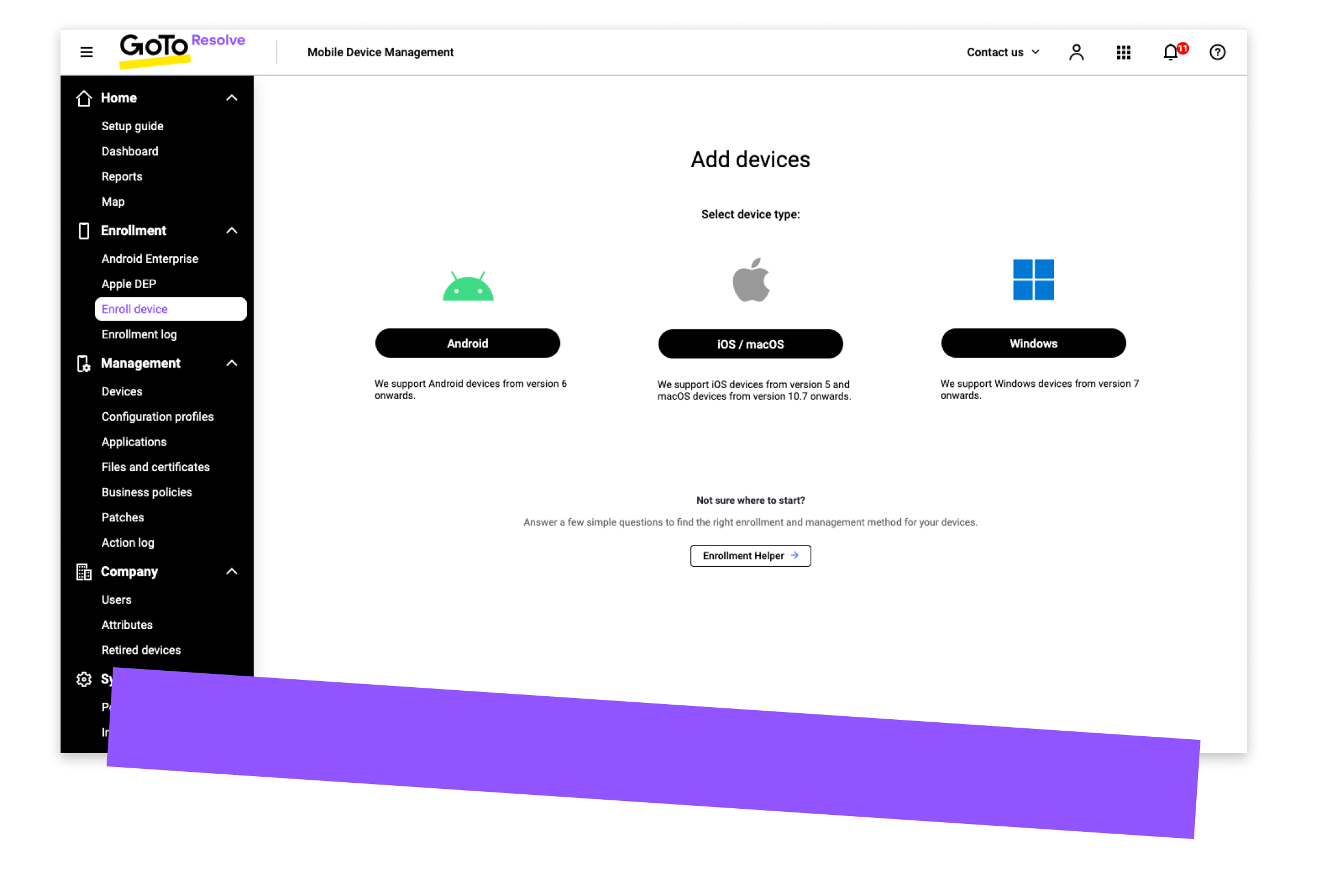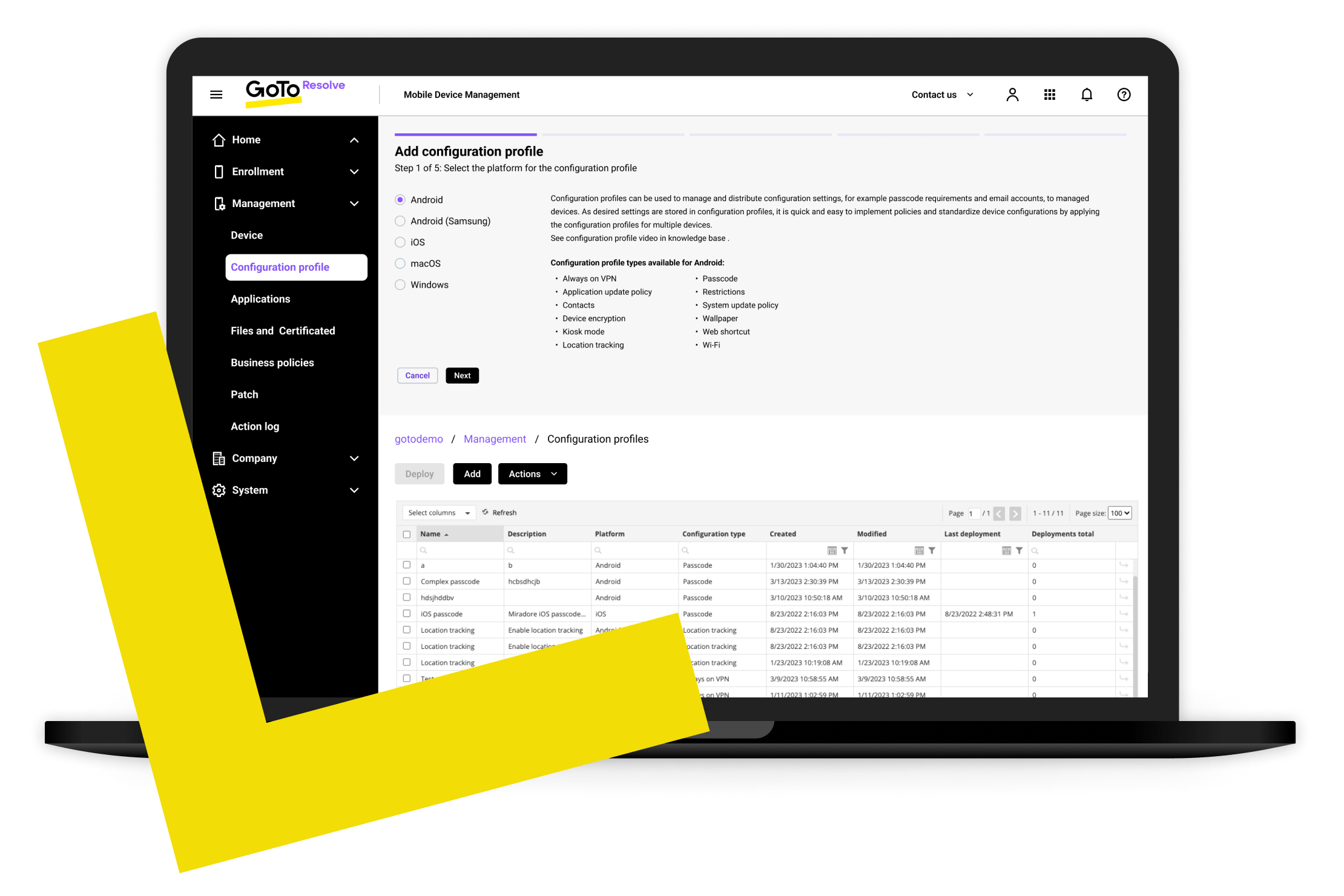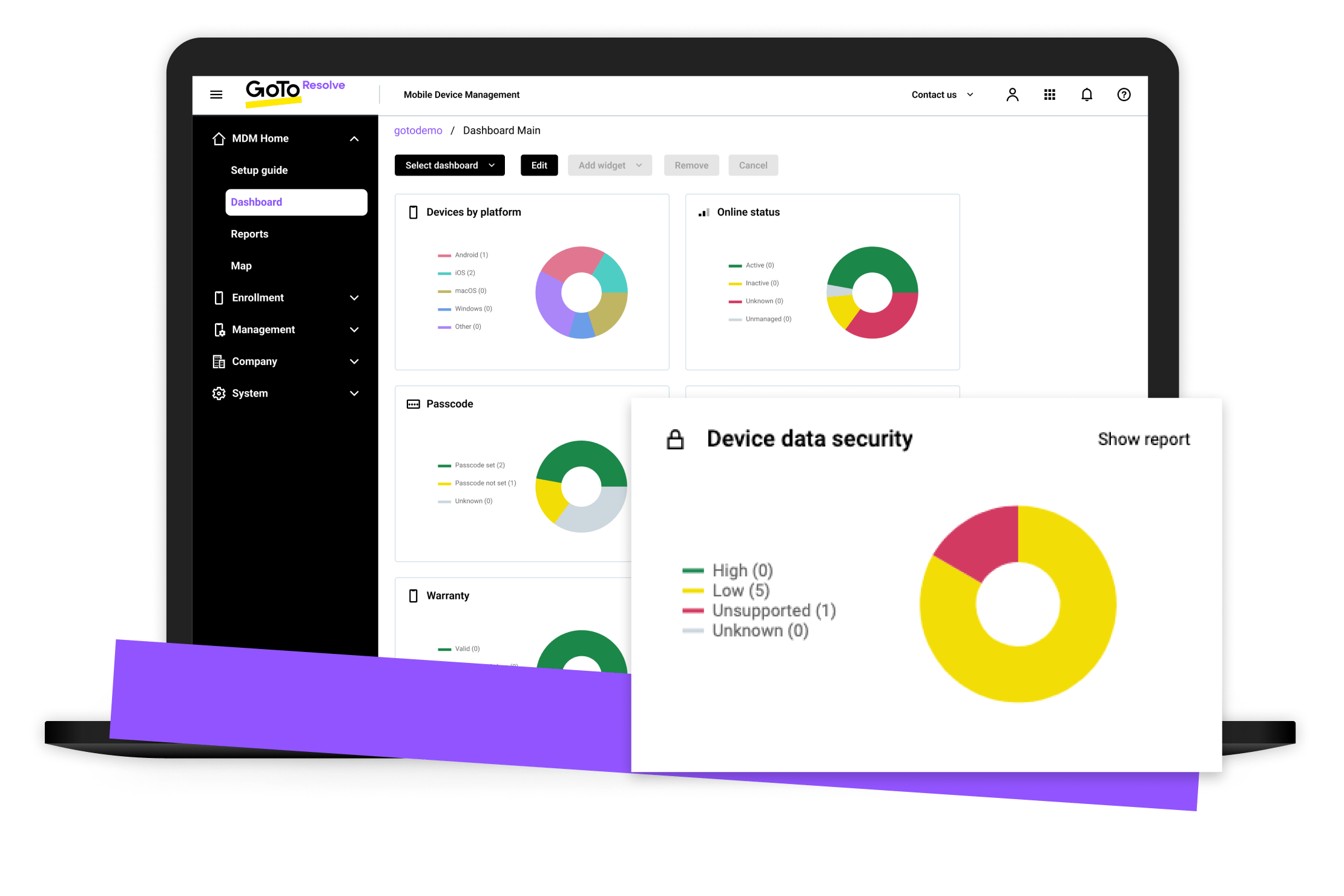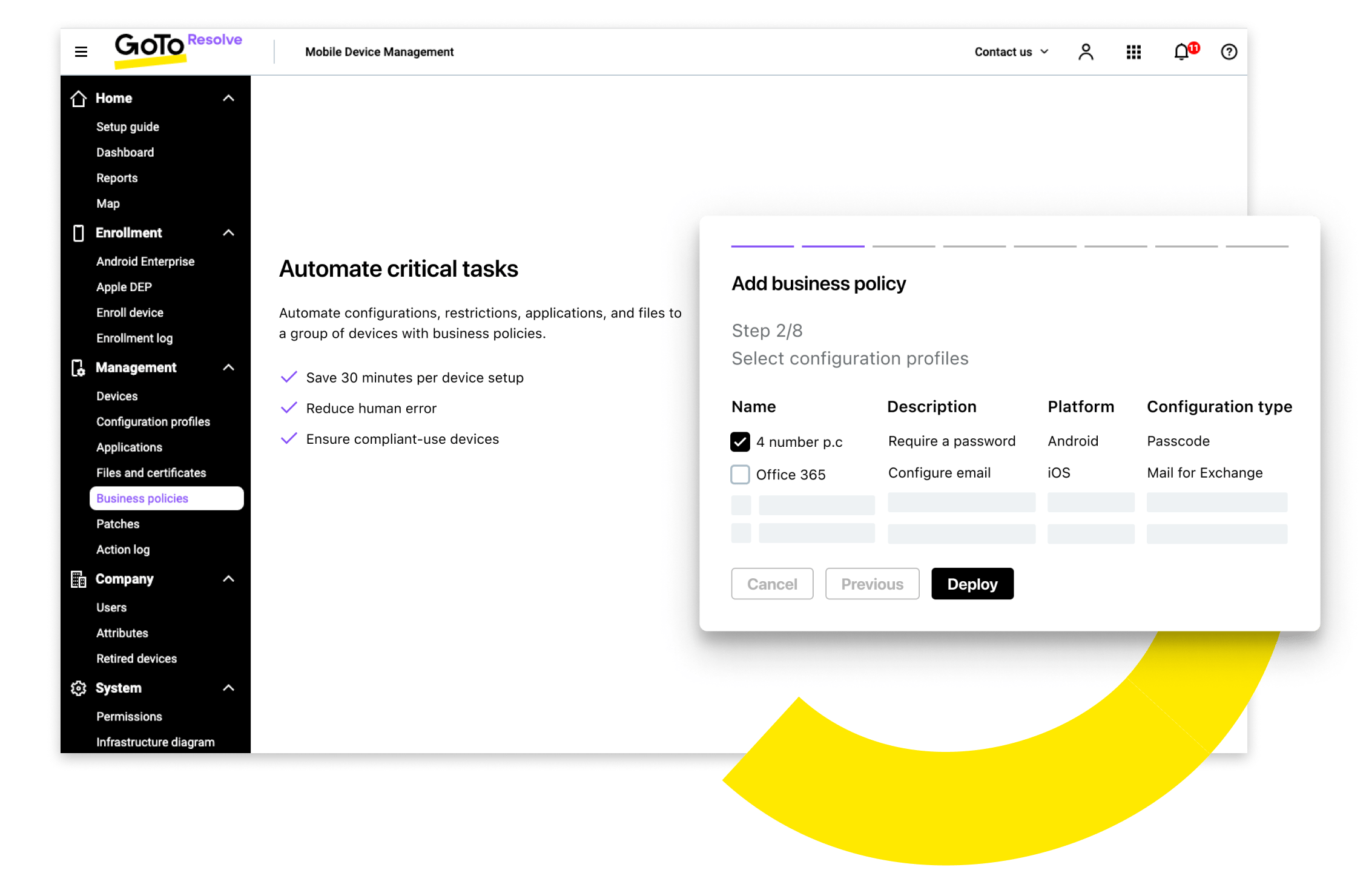Nearly everyone has a powerful, connected mobile device in their pocket, and these devices have become essential for how work and work-related communications happen today, especially in the landscape of flexible work. Businesses simply cannot work efficiently and close common security gaps unless they can remotely manage, monitor, and secure mobile devices. For this reason, Mobile device management has never been more important.

What is mobile device management (MDM)?
Organizations manage a mix of corporate-owned and personal devices being used for work. MDM is a type of software deployed by organizations to remotely monitor, manage, and secure mobile devices like smartphones, tablets and laptops.
MDM ensures data security and compliance by enforcing safe passcodes, screen locks, work profiles, and encrypting all confidential content. Because remote and hybrid employees typically use multiple devices and operating systems to remain productive, implementing mobile device management software to keep devices running smoothly is mission-critical for organizations and their IT support teams.
Cloud vs. on-premises MDM
Organizations must choose between two MDM deployment methods. In a cloud-hosted MDM deployment, a cloud/SaaS provider hosts all of your data on servers through cloud-infrastructure providers such as AWS.
Cloud-hosted MDM solutions are a good choice for anyone looking for a “plug and play” MDM solution, including most SMBs (small and midsize businesses) and larger companies wanting to drive efficiency via outsourcing.
With an on-premises MDM deployment, a provider leases its software for use on an organization’s own servers. The client would be responsible for maintaining and protecting its MDM infrastructure (they’d need internal people, processes, and IT to do so). On-premises MDM deployments are suitable for large organizations that are required to keep all data in-house.
Who uses mobile device management (MDM) software?
Any organization supporting employees who use a large number of devices, whether in in the office or in the field, should consider an MDM solution. In fact, mobile device management is a must-have for enabling hybrid and remote work and supporting both employees' productivity and business continuity.
MDM is important because the volume and use of devices is booming. Unsurprisingly, business investments in MDM are expanding – MDM investments are projected to be $21 billion by 2029, from $6 billion in 2023 and $4 billion in 2022.
-
MDM for SMBs
IT teams at small and midsize businesses (SMBs) are tasked with resolving a dizzying number of challenges around supporting flexible work. To make matters tougher, those IT teams have limited resources of budget and people, and also confront constant security threats. Mobile device management tools allow IT teams at SMBs to stay on top of their IT infrastructure and securely support employee productivity, anywhere and at all times. -
MDM for MSPs
At a time of widespread hybrid and remote work, more managed service providers (MSPs) are deploying MDM to support their client organizations. Mobile device management software provides automation and monitoring that enables MSPs to be in more than one place at a time, meeting the complex demands of their client organizations, while keeping their techs from being overloaded.
EMM vs. MDM
Enterprise mobility management, or EMM (sometimes called “enterprise mobile device management”), is an expanded version of MDM for larger organizations. The growth of smartphones and other mobile devices led to bigger gaps in data security and mobile device security that catalyzed the need for a broader suite of features, known as EMM. These expansive EMM solutions include all MDM features plus:
- Mobile application management (MAM)
- Mobile content management (MCM)
- Mobile security management (MSM)
- Containerization (BYOD)
- Identity and access management (IAM)
EMM enables enterprises to improve user experience and productivity while enhancing mobile security.

Managing different devices with MDM
You can find a mobile device management solution that enables you to manage smartphones, tablets, laptops, desktops, and other devices, such as printers, from the same portal.
Whatever MDM software you select, device manufacturers have their own, unique device enrollment and management programs that can connect to your MDM software. Here’s a brief description of programs offered by Apple, Android, and Windows:
- Apple: mobile device management for iOS
When it comes to Apple mobile device management, you will use Apple Business Manager and Apple School Manager that include Device Enrollment and Volume Purchase Program (VPP). Apple Business/School Manager is Apple’s web portal, the site from which your IT admins can enroll their Apple devices as well as manage applications and licenses by way of VPP. - Android device management
Android Zero Touch and Samsung Knox Mobile Enrollment (for Samsung devices), both of which are built-in Android mobile device management platforms, can be used to automate the enrollment of Android smartphones and tablets. In order to manage software licenses and app installations, you can use the Managed Google Play Store. - Windows device management
Microsoft’s identity and access management platform is Azure Active Directory (Azure AD). You can use it to provide your employees with seamless access to all necessary apps. Azure AD can also be leveraged for automating Windows device enrollments by connecting Azure AD to your MDM software and adding Azure AD workplace accounts to managed devices.

What can you do with MDM? Main MDM functions:
The right MDM capabilities enable IT support teams to resolve all their users’ needs across multiple devices/endpoints and locations. Here are some of the functions mobile device management software can perform:
Device Management
No matter where your IT teams or end users are located, you can automate manual tasks across tens or thousands of devices quickly and easily to ensure devices perform properly.
- Device inventory:
Mobile device management software helps companies monitor and track company-owned and bring your own device (BYOD) devices by collecting all the relevant hardware and software information. - Restrictions and configurations:
MDM enables your IT team to configure devices remotely. Different options for configurations and restrictions allow you to ensure data security and compliance, while also providing employees with the tools they need to be productive. - Application and content management:
Companies can centrally manage applications and other mobile content with MDM. Potentially harmful or malicious applications/software can be blocked or removed from devices and you can remotely update applications.

Device Security
If your devices aren’t secured, your IT infrastructure could be at risk. Put as many security tasks as possible on automatic for greater ease and peace of mind.
- Device and data security:
MDM allows companies to enforce disk encryption, use strong passcodes, and create secure containers that separate company data from personal data. And if a device gets lost or stolen, MDM allows it to be tracked and wiped remotely. - Policy enforcement:
With different policies, companies can pre-determine which configurations, restrictions, and applications should be installed on devices, and mass-deploy these policies to a group of devices. Such mass deployments save you time and ensure that devices always remain compliant.

Device ACTION
Once you know there is a problem you need to take care of, you can take actions to address them without inconveniencing the end user.
- Automation:
Most MDM solutions support automated mobile device provisioning and enrollments through Apple Business Manager / Apple School Manager, Android Zero-Touch Enrollment, or Samsung Knox Mobile program. When these built-in programs are connected to mobile device management software, companies can deploy all necessary settings and applications to devices automatically with multiple company policies. - Remote maintenance:
Mobile device management solutions enable IT teams to provide more hands-on remote maintenance and management support for device users. This includes getting device information in real time, making changes to device configurations like VPN and Wi-Fi, and managing system updates. This way, users can always rely on their devices to work properly and securely.

MDM benefits
-

Security and compliance
An MDM solution has mobile device security controls to help organizations manage IT risks by offering an effective way to safeguard devices and data, while gaining total control over the use of supported devices. It also helps organizations manage mobile device policies while staying compliant with increasing data privacy protection regulations, such as GDPR and HIPAA.
-

Save time and money
Organizations can save time (and money) by centrally managing every step of device management from a single platform, including device enrollments, configurations, and app installations. Automation of these tasks brings additional benefits, such as decreased errors and significantly faster device setups.
-

Increase workforce mobility
MDM remotely manages device enrollments, configurations, and updates, meaning that end users don’t need to waste time setting up devices. Instead, they get pre-configured devices and access to necessary data and applications from day one. MDM supports BYOD/CYOD policies, offering mobile device monitoring and mobile security.
-

Gain visibility over devices via data
Mobile device management software pulls hundreds of data points from managed devices and translates them into key performance indicators/KPIs, reports and dashboards. These real-time analytics enable organizations and their IT leaders to analyze how their managed devices are performing and also gain actionable insights into user behavior.
These comprehensive MDM reporting and analytic capabilities help organizations iterate and optimize, helping leaders make informed decisions, know exactly what’s happening with supported devices, and manage their mobile security risks.
Protecting devices and securing data with MDM
-
Mobile devices can get lost or stolen, putting your data and compliance efforts at risk. Mobile devices are also more vulnerable to cyberattacks than desktops and laptops, largely because they don’t come with pre-installed malware protection.
-
With MDM, company data can be easily protected by separating business and personal apps, enforcing safe passcodes and screen locks, and encrypting confidential content. You can also remotely remote wipe stolen or lost devices because MDM provides remote wipe iPhone and remote wipe Android capabilities.
Implementing MDM: Finding the right solution
Your requirements for device management software will largely be determined by the number of devices you support and the way those devices are being used. To help you choose the right software for your organization, consider these four factors:
-
Supported operating systems
Ensure that you can support all devices and operating systems used by the people in your organization. Some mobile device management solutions support only a specific operating system (which is obviously a big limitation), while others enable the management of multiple OSs. -
Feature requirements
You’ll want a device inventory to keep track of all your supported devices. Additionally, you’ll want the ability to add basic configurations and restrictions (e.g., email accounts, Wi-Fi/VPN settings, passcodes), as well as manage applications. As the number of your managed devices grows, you’ll also need device enrollment automation and remote software update capability. -
Usability
Choosing an MDM solution with a user-friendly interface facilitates adoption by your IT support team. If your IT people find it easy to use, they'll resolve more user issues, faster. You can browse review sites such as G2 or Capterra to see how others have rated different mobile device management tools and their usability/user experience. -
Budget
Budget is typically one of the biggest factors when choosing mobile device management software. Luckily, you can find MDM vendors that offer great features at an affordable price, with different plan options enabling you to scale up and down as needed. The most expensive option is not necessarily the best one for your needs.
The bottom line: MDM is a modern business necessity
Mobile devices, whether company-owned or not, have become an essential part of today’s modern work landscape, where work can happen anywhere over any device. Mobile devices increase employee flexibility and productivity, but when unmanaged, these devices can pose risks.
The lack of control and visibility over mobile endpoints, as well as non-standardized ways of managing mobile devices, can create costly inefficiencies and security gaps. As organizations support more flexible ways of working, they also need to protect their sensitive data and ensure compliance with data privacy regulations on every device used for work related activities. MDM enables that to happen.
Looking for a great MDM solution or unified endpoint management (UEM) solution that allows you to manage smartphones, tablets, laptops, and desktops, and more? We can help.